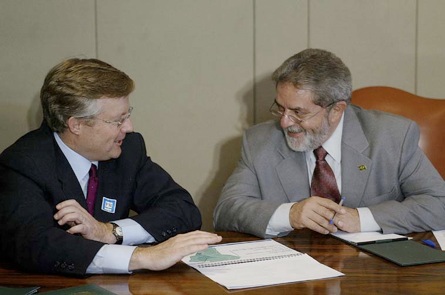2011 May blog
Geoffrey Cannon
Michael Latham
Eulogy
The eulogy for my colleague, friend and hero Michael Latham, who died last month, is published in World Nutrition this month.

'She was very big but not tall (1) and was heavily built like a peasant woman. She had beautiful eyes and a strong German-Jewish face... she reminded me of a northern Italian peasant woman with her clothes [and] her mobile face' (2).This is Ernest Hemingway on Gertrude Stein, whose picture, taken 20 years after he and she were friends, is above. She is remembered for her saying 'Rose is a rose is a rose' (the expression does not start with an 'a' and makes sense as more than a mantra, once you know that the first 'Rose' is referring to a pretty young girl, and that 'rose' can also be a name for a well-turned figure and also an elegant phrase). Friends and admirers remarked her deep velvet voice. She figures in lists of famous last statements. As she was wheeled in for the final surgery she asked 'what is the answer?' and, receiving no reply, said 'in that case, what is the question?' Researchers should bear these thoughts in mind.
There is more from Gertrude Stein and her love of French food culture, including in hard times, at the end of this column. This month though I begin with some not altogether light-hearted stuff on the right height for modern footballers and cricketers. Then I continue with a tale of food aid in the epoch of the decline and fall of the US empire – which is to say, now.
Note and reference
- 1.55 metres (5 foot 1). I think that's right but I can't find the reference. Help me out if you can, please. Some people know her best from the portrait done of her by Pablo Picasso, who was 1.62.5 metres (5 foot 4). Shortism, following the masterly WN commentary by Thomas Samaras and the accompanying WN editorial, is becoming a preoccupation. See the next item.
- Hemingway E. Miss Stein instructs. [Chapter 2]. A Moveable Feast. London: Jonathan Cape, 1982. First published 1962.
Human growth, height, size
Goooo-aaa-lll!
The linked issues of human growth, height and size have preoccupied me ever since I started to become professionally engaged in nutrition and public health, almost 30 years ago. One of the first interventions I made on the topic, in the mid 1980s, was at a symposium organised and addressed by a number of eminent authorities on paediatric nutrition. It was held in an old-fashioned-type auditorium with raked seats (maybe at the London Royal Society of Medicine before its refurbishment enabled by the munificence of Merck, Sharp and Dohme), and I was sitting high up at the back. The presentations completed, the chairman asked for questions, and I stuck up my hand. My question was: 'All the distinguished speakers today, while having different points of view on various matters, all make one fundamental assumption, which none of them has identified. Why do they all assume that it is best to be big, and that fast growth equals good health?'
Always, I will remember the reaction. Everybody in the audience, or so it seemed, turned round in their seats and stared at me, with a 'Who let him in?' expression. The chairman asked for more questions, and none of the speakers responded to my question. At the coffee break, nobody caught my eye. Oho, I thought. Maybe I have made a fool of myself. Or maybe I am on to a hot topic. (These possibilities are not mutually inconsistent, as I have noted from time to time).
Reaching for the stars
'G-oooo-aaa-lll!' is the cry made by soccer commentators here in Brazil, as the ball hits the net. It is therefore also often used here as a way to rejoice when a good point has been made. In his President's Letter published on the Association's home page in March, Barrie Margetts pointed out that the three soccer stars now identified as the best in the world, all of whom play for Barcelona, are by Western standards, short. Here they are again below, after their demolition of Arsenal in the Champions League in March, with Lionel Messi (1.69 metres or 5 foot 6½) being embraced after one of his two goals.

Are relatively short soccer players at a disadvantage? Obviously yes they are – in some ways. They are less likely to score goals with vertiginous headers. They have less brute strength. On the other hand, they have advantages. They have better balance, crucial for bamboozling opposing defenders. The world's greatest runners with the ball that come to mind, such as Diego Maradona, Manuel Francisco Dos Santos (Garrincha) and George Best, are or were short. Being compact, I guess that they are less likely to get badly injured. It would be interesting to see statistics for injuries plotted against height, of leading players. Also, short players have more stamina, crucial in crowded seasons and matches that go into extra time. G-oooo-aaa-lll !

Barrie Margetts might have given an even more outstanding example of a great sports star who is short, and so might have Thomas Samaras in his March WN commentary on reasons to be short and small. The greatest cricketing batsman of all time, indicates the sport's manual Wisden this year, is the Indian star Sachin Tendulkar, who has scored more runs and more centuries during what is so far a 22 year career at international level, in five day and also one-day matches, than any other batsman. Here he is above, in an unusual picture – after being dismissed in a Test Match, here against Australia. He is 1.65 metres in height (5 foot 5). His mentor, the great Indian batsman Sunil Gavaskar, is 1.63 metres (5 foot 4). Those who believe Donald Bradman remains the greatest batsman ever, may know he was 1.70 metres in height (5 foot 7). The most successful bowler of all time, who until the World Cup final in last month was still playing at international level, is Muttiah Muralithanan of Sri Lanka, also 1.70. Here he is below with a big grin, saying 'sorry about that' to one of the big boys in black, after a spell of 4 wickets for 25 that helped to annihilate New Zealand in the semi-finals in March.

It is often said that sportsmen like Lionel Messi, Sachin Tendulkar and Muttiah Muralithanan are great players despite being short. This is surely nonsense. An equitable aspect of soccer and cricket is that both sports accommodate players of very variable heights, including at the highest level.
While great batsmen have been and are of all heights, I reckon that a low centre of gravity, and the greater endurance of shorter batsmen, gives them an advantage especially during long innings. Tall batsmen, and also tall fast bowlers (such as Jason Gillespie, in the first cricketing picture above) have greater explosive strength as well as a longer reach. But I cannot think of any great tall cricketers who are noted for staying power and absence from injury, during and after series of very long innings or sessions. Maybe I am wrong. If I am, please use the response facility at the bottom of this column.
For his WN commentary, Thomas Samaras used four slides from my presentation at the Porto world public health nutrition congress held last September, where in debate, I was proposing the motion 'It is best to be small'. One point that struck me, as I prepared my slides, is that most of the sports considered most glamorous in the US, and therefore in many other countries, are by their nature only open at any serious level by people who are tall or big. The obvious examples are American football and basketball, where the great players look to a non-US eye almost like monsters or freaks. Within other sports, it is the specialities or categories in which by their nature athletes have to be big, tall and muscular, like sprinting and heavyweight boxing, that get the most attention. Here below, again, is the slide I prepared for the Porto congress, specifically on height and size in sports.

Like Thomas Samaras in his commentary, my purpose was to make two points. One is that in sports, the human size that is most fit for purpose depends on the nature of the sport, and that sports that require human versions of humvees are troublesome for all sorts of reasons. Two is that the preoccupation with fast growth in childhood, leading to premature sexual maturity, tall adult attained height, and very often also overweight and obesity, is a biological mistake, and is also, by analogy and directly, a social and environmental catastrophe. Let's phase out sports that require players to be enormous, or at least pay them less attention. Yes, Sumo wrestling, too (although the Japanese have got plenty to worry about just lately, before getting round to that).
US Agency for International Development
Jump-starting the roadmap

Here follows an extract from a media release issued by the US Agency for International Development at the end of January. 'Washington DC. At the annual World Economic Forum (WEF) in Davos, Switzerland, USAID Administrator Dr Rajiv Shah' (that's him above with his wife and cute kids, being sworn into office last year by Secretary of State Hillary Rodham Clinton) 'gathered with the CEOs of Unilever and Monsanto to support the launch of WEF's global framework titled Realising a New Vision for Agriculture. The show of support emphasises USAID's leadership in creating synergies between the public and private sectors to meet the global food security crisis'.
The release continues: 'Championed by 17 global companies and supported by key public and civil-society leaders, the New Vision framework outlines priorities and examples to illustrate the role businesses can play in meeting global food and nutrition needs through accelerated, sustainable agriculture-led growth. Through the US Government's Feed the Future initiative, the New Vision for Agriculture will aim to leverage private-sector investment to scale up agricultural growth in food-insecure countries. The 17 global companies that champion the initiative are: Archer Daniels Midland, BASF, Bunge, Cargill, The Coca-Cola Company, DuPont, General Mills, Kraft Foods, Metro, Monsanto Company, Nestlé, PepsiCo, SABMiller, Syngenta, Unilever, Wal-Mart Stores and Yara International'.
For readers less acquainted with industry, these transnationals are mostly conglomerates whose profits come from agribusiness, agrochemicals, ultra-processed foods and ingredients, or soft or alcoholic drinks. Ten have their head offices in the US, six in Europe, and one (Metro, assuming I have identified the correct one) in India. They are all profiled on Wikipedia (1).
The agrochemical company Bunge is an example of how transnationals, like international bankers, are top-drawer gypsies, who always follow the money and the power. Originally Dutch, the firm shifted its base of operations to Belgium, then Argentina, then Brazil. Bunge is the world's largest soybean processor, and Brazil has become the world's largest soy exporter, at 25 million tonnes in 2005. Its current Brazilian CEO Alberto Weisser, whose commercial special interest is China, moved the corporate head offices to upstate New York, because New York City, in the words of his company profile, is 'the centre of international finance and trade'. Here he is below, having a conversation with former Brazilian president Luis Inácio (Lula) da Silva, then in office. His hand is hovering over what looks like a map of Brazil.

'We are witnessing an unparalleled opportunity right now for innovative, large-scale private sector partnerships to achieve significant impact on global hunger and nutrition', the release quotes Rajiv Shah as saying. 'USAID is committed to creating new public-private partnerships in Feed the Future focus countries to advance their national investment plans'. The 20 focus countries are mostly in Africa: Ethiopia, Ghana, Kenya, Liberia, Mali, Malawi, Mozambique, Rwanda, Senegal, Tanzania, Uganda, and Zambia. Asian countries are Bangladesh, Cambodia, Nepal, and Tajikistan. Latin American countries are Guatemala, Haiti, Honduras, and Nicaragua. On this point a release says: 'USAID will work with strategic partners Brazil, India, Nigeria, and South Africa to harness the power of regional coordination and influence in these focus countries'.
Alternatively, as stated by the website www.change.org 'Shah called these companies agribusiness "champions" but they're really leaders in environmental destruction, worker exploitation, and promoting very, very unsustainable agricultural practices. This particular plan uses taxpayer dollars through Obama's Feed the Future initiative to "advance market-based solutions" to increase yield in the developing world. In other words, these companies will be exporting the Big Ag system to developing nations in the name of "feeding the world," but the only thing they'll really be feeding is their profits. As the Institute for Agriculture and Trade Policy (IATP) indicates, global trade needs to complement – not replace – local food systems'
'This ideology is exactly opposite to how the aforementioned companies have always operated. It seems that the Obama administration has bought the Big Ag bull that only a centralized, industrialized system can feed the world. Not only can sustainable, localized agriculture feed the world, but industrialized farming methods are a one-way ticket to collapse of a sustainable food system'
Some knowledgeable readers may feel that industrialised agriculture is the way of the world, is inevitable, and is the right way towards food security and to grow the economies of impoverished nations. For me this view is hard to understand, when the investment is coming from transnational companies whose power bases are in the US and Europe, now also in partnership with the emerged BRIC countries of Brazil, Russia, India and China. But this discussion is for another time. The point of this story here is to indicate what is going on.
What USAID does
In this year of 2011 USAID, created by the Kennedy administration, is 50 years old. The current overall annual budget for State Department international civilian operations, is currently around $US 55 billion a year (55.11 billion in 2010, 56.82 billion for 2011), of which USAID has a substantial chunk, with a net spend of around $US 14 billion a year. However, the amount requested for 'nutrition' for 2011 was a small fraction of this total – $US 231 million, with nothing allocated under this heading in 2010. The amount allocated for 'food security' in 2010 was just under $US 1.5 billion, and that requested for 2011 was just over $US 1.5 billion. The bigger transnational corporations can individually disburse more than these sums for strategic purposes, and do not have oversight from opinionated legislators. USAID needs corporate money, and corporations want leverage over governments. That's the deal.
The mission of USAID, as stated on its website www.usaid.gov, is to offer 'economic, development and human assistance around the world, in support of the foreign policy goals of the United States'. In other words, it has 'the twofold purpose of furthering America's foreign policy interests in expanding democracy and free markets, while improving the lives of the citizens of the developing world'. The view that this really is a 'win-win situation' (or if we include impoverished populations and equity, as well as politicians and plutocrats, a 'win-win-win-win situation') is not universally shared.
In 2010 the top recipients of US foreign aid, including from USAID, according to the Congressional Records Service at www.crs.gov , were in this order, Afghanistan, Israel, Pakistan, Egypt, Jordan, Kenya, Nigeria, South Africa, Ethiopia, and Colombia. Allocations requested for 2011 were, in order, from Afghanistan, Pakistan, Israel, Egypt, Iraq, Kenya, Jordan, Nigeria, South Africa and Ethiopia. Almost all the budget allocations for sub-Saharan countries are for HIV-AIDS programmes. There is an apparent disconnect with the Feed the Future focus countries, only two of whom appear in these lists. In any case, how can USAID bring sustained food security to sub-Saharan countries – with or without the consent of the governments and the people of these countries – if it has practically nothing in its pot to do so?
The USA is broke
The mask starts to slip off the face. The main issue here is not only that USAID is an arm of the US State Department, with priorities laid down by Congress, true though this is. Plenty of good people whose commitment is to the wretched of the earth work for USAID, though currently a number of senior posts remain unfilled. It can do work that is genuinely in the interests of the future and the people – as distinct from the current rulers – of impoverished countries.
The issue is that the USA, in common notably with the UK, has grossly over-reached its capacity in particular in imperial adventures, and reliance on what turned out to be the banking bubble. The USA is bust, broke, in most senses undeclared bankrupt (2-4). As this column is written, president Obama is asking for $US 4 trillion in public spending cuts, which include savage proposals for what is already a vicious 'healthcare' 'system'. The emperor has no dough, and as in the fable, it doesn't suit anybody attending at court to point this out.
In these circumstances, I suggest that we who work to protect and improve public health face the evidence and get real. The power to wreak will in the world is steadily and within increasing speed, passing from national governments to transnational corporations (5), collectively assembled every year at Davos. Elected politicians and their officials now cannot do much more than deflect corporate policies, or else endorse them, get in on the act, and grab some reflected glory. Politicians are ushered into the limelight and are given the credit for wise leadership, in part to preserve a façade of elected democracy, but this is smoke and mirrors. The US State Department, through USAID, did not in reality show 'leadership in creating synergies between the public and private sectors to meet the global food security crisis'. That's horsefeathers. What actually happened in Davos was that Rajiv Shah accepted an offer he could not (and as a former executive at the Gates Foundation no doubt did not want to) refuse.

There is more. Here he is above, also in Davos in January, signing a memorandum of understanding with Royal DSM NV. The initials DSM originally stood for Dutch State Mines, but after the coal ran out, the bright sparks in the firm, now a transnational with head offices in the Netherlands, turned to chemicals. Its divisions include drugs, agrochemicals, plastics, and ingredients for animal feed, pet chow, and now also kid chow and adult products (spot the difference). Its overall annual turnover is around $US 6.5 billion. DSM states that it is now the biggest supplier of synthetic vitamins and minerals in the world.
Part of the purpose of food additive companies is to offer products that replace food ingredients in the normal sense. Thus DSM (see www.dsm.com) states of its 'dairy products range' that its pre-mixes 'replace costly ingredients like cheese and tomatoes with natural equivalents that cost less and taste just as good – or even better'. Its product range is vast. Under 'M' alone, these include MATS©, Maxagusto, Maxapal©, Maxarite Delite, Maxarite Forte, Maxarome©, Maxavor©. Maxazyme©. MaxiBright. Maxilact©. Maxinvert©, Maxiren©. Maxoliva©, Maxoliva© HC, and Mycolase©. Yum yum! (I love 'Maxinvert©'. Sounds like a fruity fashion designer).
Another branded and protected ingredient is PeptoPro® This, according to DSM, 'is unique in being a pre-digested milk protein, derived from casein, which is neutral in taste. The secret lies in a patent-protected enzyme that reduces the typical bitter taste at the same time as generating tiny protein fragments (so-called peptides) that are rapidly absorbed into the bloodstream and so fuel the muscles... It is widely known that amino acids, the building blocks of proteins, are crucial for muscle function. But consuming intact proteins means these amino acids first need to be liberated by gastro-intestinal digestion and this costs precious time and energy'. Wham bam thank you m'am, max deep into the system! And there is more. 'Intact proteins can lead to discomfort during physical activity. Proteins can be pre-digested to deliver bioavailable amino acids, but this generally produces a bitter taste. PeptoPro® can be provided in a variety of pleasant tasting powders, drinks, gels or energy bars.'
According to its media release, 'DSM is the only global company that integrates single vitamins and premixes in ideal formulations for targeting developing-country beneficiaries with innovative solutions such as Nutririce®, a fortified rice kernel created from broken rice kernels, and MixMe®, a micronutrient powder for home fortification which has been widely adopted through the World Food Program and other agencies in emergencies worldwide. DSM maintains a successful partnership with the WFP to improve the nutritional value of products in WFP's "food basket" and has received numerous awards for its work in finding sustainable solutions to micronutrient deficiency, including awards from the Global Alliance For Improved Nutrition and the 2010 World Business Development Award'. DSM CEO Feike Sijbesma has a declared commitment to help his company end world hunger, and in 2010 he received the Humanitarian of the Year Award from the United Nations Association of New York.
The agreement between DSM and USAID was summarised by DSM in a statement released through Reuters. It said: 'They will collectively work to meet the nutritional challenges presented in the developing world' and that they 'expect to leverage their respective competencies, expertise, products and services to support collaborative activities focused on meeting the micronutrient needs of populations in the developing world… The initial focus of the collaboration will be on rice fortification; achievement of the nutrition objectives as part of Feed the Future, the US Government's global hunger and food security initiative, and the United States Global Health Initiative; support of the 1,000 days efforts to help countries jumpstart the Scaling Up Nutrition Road Map with the support of other development partners. In addition, DSM will provide input to USAID's Office of Food For Peace in order to help improve nutritional value, quality, shelf life, and methods for testing food aid commodities'.
Rajiv Shah was enthusiastic, As quoted, he said: 'We are witnessing an unparalleled opportunity right now for innovative, large-scale private sector partnerships to achieve significant impact on global hunger and nutrition. USAID is proud to build this new partnership with DSM, the world's largest manufacturer of micronutrients and vitamins. Together we can improve childhood nutrition in countries that depend on rice as a staple crop'.
Maxagusto, anyone? So there you have it. It's all about leveraging a jump-start to a roadmap.
Notes and references
- This and other items in my columns, include links and are lightly referenced. The information on which I rely is readily found on the internet, usually on the sites of the relevant companies and organisations.
- Johnson C. The Sorrows of Empire. Militarism, Secrecy, and the End of the Republic. New York: Henry Holt, 2004.
- Fergusson N. Colossus. The Rise and Fall of the American Empire. New York: Penguin, 2004.
- Stiglitz J, Bilmes L. The Three Trillion Dollar War. The True Cost of the Iraq Conflict. New York: Norton, 2008.
- This is not a new phenomenon. Globalisation is new only in its present form. Since the European middle ages, the wars and empires of the Great Powers were financed by transnational banking houses and by international corporations such as the East India and the West India Companies. Also as now, almost the only really big decisions that rulers, whether dynastic or elected, could take, was to declare war, and such decisions would be backed with money and material only when this was in the interests of bankers and traders. This helps to explain why so many wars were and are fought. Prudent rulers ensured that they could finance and ensure glory. One reason for shifts in balances of power, and the rise and fall of empires, has been the decisions of bankers either to lend money or pull the plug, or else banks and traders going bust.
Gertrude Stein
French bread
And then we went on to talk about climate and the things each nation drinks and the food it eats. Yes he said I do understand that here in France we make normally a wine that is rarely more than nine degrees of alcohol, and that we can drink that with our meals and indeed we can even put water into our wine as many do, and we drink a nice wine while eating, but the Hungarians who drink a heavy wine, they drink water with the meal and they drink their heavy wine after. As do the Spaniard and the Portuguese too, I said, it is all a question of climate…. Then he sighed, he said they talk about the United States of Europe but he said that can never come about the food and the drink of each country in Europe is too different… It is strange, he went on, very strange that in such a small continent as is Europe there should be so many kinds of climate, so many kinds of food and drink. It is strange, he said, and I took my two delicious cakes and my two loaves of bread and slung it on my back and Basket and I went home as we always do in the winter evening.
Gertrude Stein, 1874-1946
Wars I Have Seen, 1945 (1)
The time was January 1944, and the place was Bilignin in eastern France, not far from Switzerland – and near Bourg-en-Bresse, where 60 years previously, as told in last month's column, Henry James had enjoyed boiled eggs (2). Gertrude Stein, her companion Alice Toklas, and Basket her poodle, had moved from Paris, and she had decided to see the war out in Vichy France, despite being Jewish, as was Alice Toklas
Her writing, and writing about her, constantly refers to her love of food, sophisticated or simple, and where it came from. Twenty years previously she had introduced Ernest Hemingway to her Paris, and some of its great writers and painters – including Pablo Picasso, who painted her portrait. Much later Hemingway wrote of her enchanting apartment: 'it was warm and comfortable and they gave you good things to eat and tea and natural distilled liqueurs made from purple plums, yellow plums or wild raspberries. These were fragrant, colourless alcohols served from cut-glass carafes in small glasses and whether they were quetsche, mirabelle or framboise they all tasted like the fruits they came from, converted into a controlled fire on your tongue that warmed you and loosened it' (3).
The passage I quote above, contains yet another example of how, with food – and other matters – the same word may refer to different things. Any kind of wine has various properties in common, such as (usually) being made from grapes. But a local fresh light wine diluted with water to say 7 per cent of alcohol, is a very different drink from wine that's travelled round the world, and which is 13 or even 14 or more per cent alcohol. (I will not mention sulphites). Why has wine steadily become so much more alcoholic? Assuming you drink it, have you tried these days to find wine that is 11 or even 12 per cent alcohol? It seems to me, backed by data on rocketing rates of alcohol-fuelled mayhem, that the function of heavy wine with alcohol content not far short of sherry, is to get its drinkers wrecked as fast as possible, whereas the light diluted wines enjoyed by Gertrude Stein's community were consumed as part of delicious meals prepared and cooked from local produce, and indeed also as gentle tongue-looseners, for meals are also all about family and friends and plans and ideas.
What Gertrude Stein does not mention is that in those days, outside its cities France was largely a nation of peasant farmers, and shopkeepers and traders who supported the farmers and their families, as were other European countries, including Italy. Britain was the exception. Its class of peasantry had been exterminated: uprooted by land-owners, and driven out of the countryside, either to the newly industrialised cities or to other countries (4). In France the Revolution and then the Napoleonic property laws meant that peasant farmers owned their land (5), and the French laws of inheritance, whereby all children by right shared patrimony, tended to make farms increasingly small.
This, as much as the weather, accounted for the wonderful variety of food produced in France. Gertrude Stein observed: 'The quantity of food that the fields of France can produce cultivated by a few oldish men and women and children is perfectly extraordinary… A mother and a father not very strong with an aged parent and one or two young children, and the amount of food, of wheat, of wine, of brandy, or potatoes, of vegetables, of cows and goats, of butter and milk, of pigs and chickens and ducks and oxen and food for all these animal and for themselves, the amount of food that these five or six people can produce in a year and not working very hard, all the time but not awfully hard… is an eternal miracle… Of course every workman has a garden and that garden does produce a lot of food, for himself and family, of course and I forgot rabbits, everybody keeps rabbits and eats them'.
Eternal? A little more than half a century later, this way of life is almost all gone now, in continental Europe, even in the fastnesses of France. After the next two great financial crashes, surely bound to come, which for high-income countries now are the equivalent of the wars Gertrude Stein saw and survived with grace under pressure, these times may come again. Rabbit stew is delicious.
References and note
- Stein G. Wars I Have Seen. London: Batsford, 1945.
- Hemingway E. Miss Stein instructs. [Chapter 2]. A Moveable Feast. London: Jonathan Cape, 1982. First published 1962.
- James H. A Little Tour in France. London: Sidgwick and Jackson, 1987. First published 1884.
- Somebody, it might have been me, once observed: 'Britain has the worst food in the world, and the best nutritionists in the world, and each is the cause of the other'. There is truth in the joke. Nutrition science in its first century, roughly between 1840 and 1950, was mainly concerned with the prevention and treatment of deficiency diseases, and the need to grow big strong men and women to fight land wars and to work in factories. In Britain, development of the science was driven by the physical condition of the 19th and early 20th century British working classes, which as recorded among many others by Friedrich Engels, was appalling and outrageous. An echo of this joke is the observation that the profession of nutrition is uniquely weak in France, because the French do not need nutritionists to tell them what to eat.
- Hobsbawm E. Land [Chapter 8]. The Age of Revolution, 1789-1848. London: Weidenfeld and Nicolson, 1962.
Acknowledgement and request
You are invited please to respond, comment, disagree, as you wish. Please use the response facility below. You are free to make use of the material in this column, provided you acknowledge the Association, and me please, and cite the Association’s website.
Please cite as: Cannon G. G-oooo-aaa-lll ! and other items. [Column] Website of the World Public Health Nutrition Association, May 2011. Obtainable at www.wphna.org
The opinions expressed in all contributions to the website of the World Public Health Nutrition Association (the Association) including its journal World Nutrition, are those of their authors. They should not be taken to be the view or policy of the Association, or of any of its affiliated or associated bodies, unless this is explicitly stated.
This column is reviewed by Barrie Margetts and Fabio Gomes. My thanks also to Google, Wikipedia, and Guardian On-Line. Special thanks this month to my good friend Guilherme Faule of VIP Services, and his surgeons, who gave my Acer Aspire 5610 a Word 7 transplant in one day, and yet saved all my stuff. God backs up those who back themselves up.






